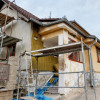Should I Refinish My Hardwood Floors?
Hardwood floor refinishing is an intricate process that must be handled carefully and meticulously; working with someone experienced is imperative to ensure success. Assure the space is warm and well-ventilated to reduce odors and speed the drying time of the finish. Remove furniture, curtains and pictures before beginning refinishing. Screen and recoat maintenance works best when conducted before you see scratches through the stain. Signs That Your Floors Need to Be Refinished If your hardwood floors have become darker around large windows, this could be an indicator that they need refinishing due to sun's UV rays deteriorating their floorboards over time. Sanding and refinishing will address this problem effectively. Scratches on your floors are another telltale sign that they need to be refinished. Minor surface-level scratches may not require attention, but once they penetrate through to the wood itself it may be time for refinishing. If your floors bend when you walk on them, this is a serious indication that needs immediate refinishing. Called cupping, this condition indicates water damage from spills or humidity problems that must be corrected through sanding. Cupping should never be ignored since it could lead to significant structural damage to your home; hiring professional help for this task should be prioritized immediately. Sun-Bleached Spots While regular sweeping and mopping will keep hardwood floors looking their best, sunlight will cause them to gradually fade over time. If your floor's vibrancy has decreased since they were new, refinishing might be needed. It is also wise to install curtains or blinds around windows to block harmful UV rays for optimal results. Scratches on hardwood are common, but when they reach all the way through to reveal the wood's core it could be time for a refinish. Not only are these scratches unsightly but they allow moisture to enter and cause lasting damage to your floor. Discoloration may occur for various reasons, with water damage being the most frequently mentioned culprit. Over time, wood stains absorb moisture and turn gray or black over time; applying new stain may help solve this issue; however, in extreme cases refinishing could be required as replacement may not be an option. Water Damage If your hardwood floors have become stained or damaged, professional restoration services can restore them through sanding and refinishing. However, depending on the extent of damage sustained it may be better to refinish or replace your floors altogether. Water damage to your floors is often an indicator that it needs refinishing, whether from flooding, plumbing issues or an air conditioner that leaks. Water damage to your floors can cause staining, discoloration and other physical harm to them. Furthermore, it can warp wood grains causing bowing or cupping as well as crowning (uneven edges on wood pieces) on edges that become uneven due to crowning. Locating and drying out water sources quickly can reduce the chance of hardwood replacement being necessary; however, in cases of extreme damage such as black boards, severe separation, or major cupping they may need replacing entirely. Damaged Wood Refinishing hardwood floors when damaged areas begin to appear is essential in protecting their value and keeping pests at bay. Damage from pet claws or furniture cannot always be easily identified, while this kind of damage exposes dangerous splinters and nails which could endanger family safety. Sanding and refinishing will protect home values as well as prevent pests from entering through exposed splinters. Natural sunlight can also damage hardwood floors and cause them to fade or discolor over time, signaling UV rays from the sun rays have penetrated their core material and caused irreparable damage. While applying fresh stain may help, in many cases having your hardwoods professionally refinished is usually the most cost-effective solution. One sure sign that it may be time for your floors to be refinished is when they begin showing signs of moisture damage, usually evident by a dull gray hue on their surface. This indicates that polyurethane may have broken down and allowed water to seep into them, signalling their need for repainting.
Appreciation Spotlight
The articles provided on HandyPerson.com were useful, timely, and informative. I learned a lot of information that helped have more informed conversations with contractors -- all for free. Thanks, HP!

